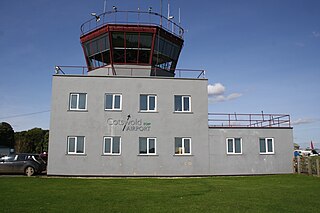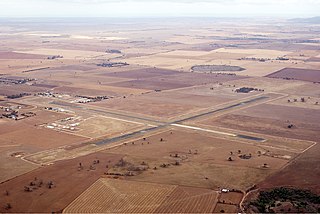
Moorabbin Airport is a mostly general aviation airport for light aircraft located in between the southern Melbourne suburbs of Heatherton, Cheltenham, Dingley Village and Mentone. It also receives commercial airline service. The airport grounds are treated as their own suburb, and share the postcode 3194 with the neighbouring suburb of Mentone. With a total of 274,082 aircraft movements, Moorabbin Airport was the second busiest airport in Australia for the calendar year 2011.
Royal Air Force Long Kesh, or more simply RAF Long Kesh, is a former Royal Air Force station at Maze, Lisburn, Northern Ireland.

Essendon Fields Airport, colloquially known by its former name Essendon Airport, is a 305 ha public airport serving scheduled commercial, corporate-jet, charter and general aviation flights. It is located next to the intersection of the Tullamarine and Calder Freeways, in the north western suburb of Essendon Fields of Melbourne, Victoria, Australia. The airport is the closest to Melbourne's City Centre, approximately an 11 km (6.8 mi) drive north-west from it and 8 km (5.0 mi) south-east from Melbourne–Tullamarine Airport. In 1970, Tullamarine Airport replaced Essendon as Melbourne's main airport.

Cotswold Airport is a private general aviation airport, near the village of Kemble in Gloucestershire, England. Located 4.5 NM southwest of Cirencester, it was built as a Royal Air Force (RAF) station and was known as RAF Kemble. The Red Arrows aerobatics team was based there until 1983. Since 2000, it is used for the storage and recycling of retired airliners, as well as flying schools, clubs, and industry.

Ryan Airfield, also known as Ryan Field, is a city-owned, public-use airport located 12 miles southwest of the central business district of Tucson, a city in Pima County, Arizona, United States. It is included in the National Plan of Integrated Airport Systems for 2011–2015, which categorized it as a reliever airport. It is mostly used for general aviation but also serves a significant amount of law enforcement and military helicopter activity. Approximately 50% of Ryan's traffic is training-related.

Haverfordwest Airport, also known as Withybush Airport, is a minor airport located 2 NM north of Haverfordwest, Pembrokeshire. It is on the site of the former RAF Haverfordwest, which was operational between 1943 and 1945. Pembrokeshire County Council bought the site in the 1950s, and it has been a civil airfield since, with a number of other organisations also using it.

Caernarfon Airport, is a general aviation airport located 4 nautical miles southwest of Caernarfon, Gwynedd, Wales. It is on the site of the former RAF Llandwrog which was operational between 1941 and 1946. From the end of the 1960s, civil light aircraft started to use the aerodrome in greater numbers and eventually gained a full operating licence in 1976.

Newtownards Aerodrome is a local airfield in Newtownards, County Down, Northern Ireland. It is located 8.5 NM east of Belfast. This airport offers light aircraft flights, helicopter flights, microlight flights and flight simulator training. The airport also has an onsite restaurant.

Old Sarum Airfield is a grass strip airfield 2 nautical miles north-north-east of Salisbury, Wiltshire, England.

Heston Aerodrome was an airfield located to the west of London, England, operational between 1929 and 1947. It was situated on the border of the Heston and Cranford areas of Hounslow, Middlesex. In September 1938, the British Prime Minister, Neville Chamberlain, flew from Heston to Germany three times in two weeks for talks with Adolf Hitler, and returned to Heston from the Munich Conference with the paper referred to in his later "Peace for our time" speech from 10 Downing Street.

Weston Airport, also called Dublin Weston Airport, is a publicly licensed general aviation (GA) airport serving Dublin and its environs since the early 1930s. It is located between Leixlip, County Kildare, and Lucan, Dublin 8 NM west of Dublin. Its traffic is primarily private and commercial flight training as well as business/executive travel. It is the only general aviation airport in the greater Dublin region, and is home to one of Ireland's two approved training organisations for ab-initio professional pilot training.
The Bellman Hangar was designed in the United Kingdom in 1936 by the Directorate of Works structural engineer, N. S. Bellman, as a temporary aircraft hangar capable of being erected or dismantled by unskilled labour with simple equipment and to be easily transportable. Commercial manufacturing rights were acquired by Head Wrightson & Co of Teesdale Iron Works, Thornaby-on-Tees. By November 1938, 10 had even been supplied to Russia.

Wycombe Air Park, also known as Booker Airfield, is an operational general aviation aerodrome located in Booker, Buckinghamshire, 2.4 nautical miles south-west of High Wycombe, England. The airfield celebrated its 50th year of opening on 25 April 2015. It originally opened in 1941 as RAF Booker and was primarily involved in training during World War II, remaining a military establishment until 1965.
The Royal Victorian Aero Club is an Australian aero club based at Moorabbin Airport in Melbourne.

Ethel Marian Sumner "Maie" Casey, Baroness Casey was an Australian pioneer aviator, poet, librettist, biographer, memoirist and artist. Lord Casey was her husband.

Temora Airport is a small airport located 2 nautical miles northwest of Temora, New South Wales, Australia. Currently no regularly scheduled passenger fights serve the airport. The current owner, the Temora Shire Council, do not charge landing fees for aircraft to use the facility, encouraging a wide variety of general aviation uses, including skydiving, gliding, flight training, kit aircraft assembly and aircraft maintenance. It is also the home of the Temora Aviation Museum, and hosts regularly flying displays and events.

Bacchus Marsh Airfield is located 3.5 nautical miles south of Bacchus Marsh, Victoria, Australia.

Richard Gavin Gardiner Casey, Baron Casey, was an Australian statesman who served as the 16th Governor-General of Australia, in office from 1965 to 1969. He was also a distinguished army officer, long-serving cabinet minister, Ambassador to the United States, member of Churchill's War Cabinet, and Governor of Bengal.
Cramlington Aerodrome was a military airfield established in Northumberland during the First World War. It became a civil airfield serving the Tyneside area of north-east England and operated until 1935, when it was replaced by Woolsington Airport, now known as Newcastle International Airport.
Solent Airport Daedalus is a general aviation airport in Hampshire, England.
















